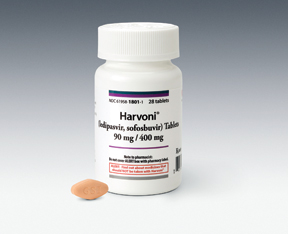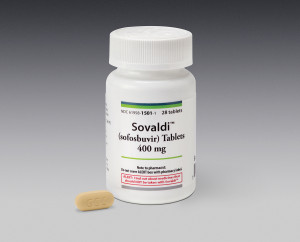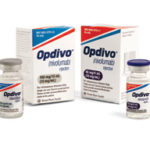Gilead 2017: We Got Next
With sales of Harvoni and Sovaldi falling off, Gilead welcomed two new blockbusters to the company’s portfolio in 2016.
Gilead Sciences Inc.
333 Lakeside Drive
Foster City, CA 94404
Telephone: 650-574-3000
Website: gilead.com
Best-Selling Rx Products
| PRODUCT | 2016 SALES | 2015 SALES |
|---|---|---|
|
Harvoni |
$9,081 | $13,864 |
|
Sovaldi |
$4,001 | $5,276 |
|
Truvada |
$3,566 | $3,459 |
| Atripla | $2,605 | $3,134 |
| Stribild | $1,914 | $1,825 |
| Epclusa | $1,752 | N/A |
| Genvoya | $1,484 | $45 |
| Complera/Eviplera | $1,457 | $1,427 |
| Viread | $1,186 | $1,108 |
All sales are in millions of dollars.
Financial Performance
| 2016 | 2015 | |
|---|---|---|
| Revenue |
$30,390 |
$32,639 |
| Net income |
$13,501 |
$18,108 |
| Diluted EPS |
$9.94 |
$11.91 |
| R&D expense |
$5,098 |
$3,014 |
| 1H 2017 | 1H 2016 | |
|---|---|---|
| Revenue |
$13,646 |
$15,570 |
| Net income |
$5,775 |
$7,063 |
| Diluted EPS |
$4.38 |
$5.11 |
| R&D expense |
$1,795 |
$2,749 |
All figures are in millions of dollars, except EPS.
The hepatitis C products Harvoni and Sovaldi were about as transformative as prescription drugs get when they launched, even accounting for the rampant overuse of the word. Sovaldi generated more than $10 billion in sales in its first full year on the market, 2014, while Harvoni reached almost $14 billion in its own first full year, 2015. With the extraordinary speed of innovation in the hep C space, though, not to mention their own extraordinary effectiveness, sales of the two have slowed significantly in the past year and a half.
Of course, even a significant slowdown is not so bad when you start in the tens of billions; combined sales of Harvoni and Sovaldi were still more than $13 billion in 2016. And Gilead’s next generation of antivirals are already making plenty of noise for the company, with Epclusa and Genvoya generating more than $3.2 billion in combined sales last year. So while the record-breaking launch days may be past, Gilead’s product portfolio is still doing just fine, thank you very much.
“This year marks Gilead’s 30th anniversary,” says John Milligan, the company’s CEO. “I joined Gilead more than 27 years ago as a research scientist and have worked in many different roles over the years, completing my first year as CEO in March. Being part of a company that has transformed care and made a difference in the lives of so many individuals is something that I carry with me every day, as do all Gilead employees.”

“This year marks Gilead’s 30th anniversary,” says CEO John Milligan. “Being part of a company that has transformed care and made a difference in the lives of so many individuals is something that I carry with me every day, as do all Gilead employees.”
Gilead’s top-line sales were $30.39 billion in 2016, down 6.9 percent compared with the previous year. Net income fell by 25.4 percent to a still-robust $13.5 billion, third among the top 50 pharma companies even though Gilead’s revenue rank was eighth. Diluted earnings per share for the year were down by $1.97 to $9.94. In the first half of 2017, Gilead sales fell by 12.4 percent to $13.65 billion, while net income was down 18.2 percent to $5.78 billion and EPS dropped 73 cents to $4.38.
Kite Pharma Acquisition
During August, Gilead and Kite Pharma Inc. announced that the companies had entered into a definitive agreement pursuant to which Gilead would acquire Kite for $180.00 per share in cash. The transaction, which values Kite at about $11.9 billion, was unanimously approved by both the Gilead and Kite Boards of Directors and is anticipated to close in the fourth quarter of 2017.
According to company executives, Kite is an industry leader in the emerging field of cell therapy, which uses a patient’s own immune cells to fight cancer. The company has developed engineered cell therapies that express either a chimeric antigen receptor (CAR) or an engineered T cell receptor (TCR), depending on the type of cancer. Kite’s most advanced therapy candidate, axicabtagene ciloleucel (axi-cel), is a CAR T therapy currently under priority review by FDA. It is expected to be the first to market as a treatment for refractory aggressive non-Hodgkin lymphoma, which includes diffuse large B-cell lymphoma (DLBCL), transformed follicular lymphoma (TFL), and primary mediastinal B-cell lymphoma (PMBCL). FDA has set a target action date of Nov. 29, 2017 under the Prescription Drug User Fee Act. A marketing authorization application has also been filed for axi-cel for the treatment of relapsed/refractory DLBCL, TFL, and PMBCL with the European Medicines Agency, representing the first submission in Europe for a CAR T therapy. Approval in Europe is expected in 2018. Kite has additional candidates in clinical trials in both hematologic cancers and solid tumors, including KITE-585, a CAR T therapy candidate that targets BCMA expressed in multiple myeloma.
“The acquisition of Kite establishes Gilead as a leader in cellular therapy and provides a foundation from which to drive continued innovation for people with advanced cancers,” Dr. Milligan says. “The field of cell therapy has advanced very quickly, to the point where the science and technology have opened a clear path toward a potential cure for patients. We are greatly impressed with the Kite team and what they have accomplished, and share their belief that cell therapy will be the cornerstone of treating cancer. Our similar cultures and histories of driving rapid innovation in order to bring more effective and safer products to as many patients as possible make this an excellent strategic fit.”
Product Performance
Most companies would not call a 34.5 percent drop in revenue for their lead product a win. But even after that drop, the hepatitis C drug Harvoni remained the second-best selling prescription drug in the world, with $9.08 billion in sales in 2016. Sales of Harvoni’s cousin Sovaldi also dropped by 24.2 percent, to $4 billion. The tumble continued into the new year, with Harvoni sales down another 50.7 percent to $2.75 billion and Sovaldi sales collapsing 76.2 percent to $628 million in the first half of 2017.

Sales of Harvoni and Sovaldi fell sharply in 2016, but the two drugs still combined to generate more than $13 billion for Gilead.
In April, Gilead announced results from two Phase II studies evaluating Harvoni tablets in chronic hepatitis C virus-infected patient populations not previously studied in dedicated clinical trials with direct-acting antiviral therapies. The studies demonstrated HCV cure rates of 99 percent in children aged 6 years to 11 years, and 100 percent in adult patients co-infected with HCV and hepatitis B virus.
“Gilead continues to study the safety and efficacy of our medicines in HCV-infected patients with unmet medical need, to help realize the potential for cure,” says Norbert Bischofberger, PhD, Executive VP, Research and Development and Chief Scientific Officer, Gilead Sciences. “In these studies of younger children with hepatitis C and HCV/HBV co-infected patients, Harvoni achieved high cure rates and demonstrated safety consistent with the known profile of the drug.”
Also in April, FDA approved supplemental indications for Harvoni and Sovaldi for the treatment of chronic hepatitis C virus infection in adolescents without cirrhosis or with compensated cirrhosis, 12 years of age and older, or weighing at least 35 kilograms. Harvoni was approved for pediatric patients with genotype 1, 4, 5, or 6 chronic HCV infection. Sovaldi was approved for pediatric patients with genotype 2 or 3 chronic HCV infection, in combination with ribavirin. There are an estimated 23,000-46,000 pediatric HCV patients in the United States, most of whom were infected with the virus at birth. 
On the flip side to Harvoni and Sovaldi, Gilead crowned two brand-new blockbuster products in 2016. The first, the hepatitis C drug Epclusa, earned $1.75 billion in sales in just half the year after being approved by FDA in June, and added another $2.06 billion in the first half of 2017. The second, the HIV product Genvoya, rolled up $1.48 billion in sales for 2016 after being launched in late 2015, and already beat that number in the first half of 2017 with $1.63 billion in sales.
During February, Gilead announced 144-week data from two Phase III clinical studies (Studies 104 and 111) evaluating the safety and efficacy of Genvoya for the treatment of HIV-1 infection in treatment-naïve adults. Through Week 144, Genvoya demonstrated significantly higher rates of virologic suppression compared to Stribild, based on the percentage of patients with HIV-1 RNA levels less than 50 copies/mL. Patients receiving Genvoya also demonstrated favorable renal and bone laboratory parameters compared to those treated with Stribild.
In the combined analysis of Studies 104 and 111, a total of 1,733 treatment-naïve adults with HIV were randomized to receive either Genvoya or Stribild. At Week 144, 84.2 percent of patients taking Genvoya and 80 percent of patients taking Stribild achieved HIV-1 RNA levels less than 50 copies/mL. Additionally, at Week 144, 81.1 percent of patients taking Genvoya and 75.8 percent of patients taking Stribild achieved HIV-1 RNA levels less than 20 copies/mL, a secondary endpoint. At Week 144, virologic failure was similar between groups (Genvoya, 4.6 percent; Stribild, 3.9 percent); the difference in overall results was driven by fewer discontinuations on Genvoya due to adverse events or other reasons not related to efficacy (Genvoya, 11.2 percent; Stribild, 16.0 percent).
In August, FDA approved updated labeling for Epclusa, making it the first all-oral, pan-genotypic, once-daily single tablet regimen for the treatment of adults with chronic hepatitis C virus infection, to include use in patients co-infected with HIV. The supplemental new drug application was supported by data from the open-label, Phase III ASTRAL-5 study, which evaluated 12 weeks of treatment with Epclusa in 106 subjects with genotype 1-4 HCV infection who were co-infected with HIV and on stable antiretroviral therapy. In the study, 95 percent of patients achieved the primary endpoint of SVR12, defined as an undetectable viral load 12 weeks after completing therapy.
“Epclusa has already helped further simplify HCV treatment among mono-infected patients, and we are pleased that HCV/HIV co-infected patients can benefit from this pan-genotypic single tablet regimen,” Dr. Milligan says. “This approval advances the commitment we’ve made to the HCV and HIV communities to deliver innovative new treatments that address their unmet medical needs.”
In The Pipeline
In January, the European Commission granted marketing authorization for Vemlidy (tenofovir alafenamide, TAF) 25 mg, a once-daily tablet for the treatment of chronic hepatitis B virus infection in adults and adolescents (aged 12 years and older with body weight at least 35 kg). TAF is a novel, targeted prodrug of tenofovir that has demonstrated antiviral efficacy similar to Gilead’s Viread (tenofovir disoproxil fumarate, TDF) 245 mg, but at one-tenth the dose. Data show that because TAF has greater plasma stability and more efficiently delivers tenofovir to hepatocytes (cells of the liver) compared to TDF, it can be given at a lower dose, which means there is less tenofovir in the bloodstream. By reducing exposure to tenofovir, TAF is associated with improved renal and bone laboratory safety parameters compared to TDF in clinical trials.
TAF’s approval was supported by 48-week data from two international Phase III studies (Studies 108 and 110) in 1,298 adult chronic HBV patients. Study 108 randomized 425 HBeAg-negative patients to receive either TAF or TDF, and Study 110 randomized 873 HBeAg-positive patients to receive either TAF or TDF. Both studies met their primary endpoint of non-inferiority to TDF based on the percentage of patients with chronic hepatitis B with plasma HBV DNA levels below 29 IU/mL at 48 weeks of therapy. Patients in the TAF arm of the trials also experienced numerically higher rates of normalization of blood serum alanine aminotransferase (ALT) levels. Vemlidy was approved by FDA in November 2016 for the treatment of chronic HBV infection in adults with compensated liver disease, and by the Japanese Ministry of Health, Labour and Welfare in December 2016 for the suppression of viral replication in chronic hepatitis B patients with evidence of hepatitis B virus replication and abnormal liver function.
“TAF reflects Gilead’s ongoing commitment to improve and simplify care for people with chronic infectious diseases, including hepatitis B, while we continue our research efforts for curative treatments,” Dr. Bischofberger says. “We look forward to making TAF available as quickly as possible throughout the European Union.”
In February, Gilead announced data from a Phase II study evaluating the efficacy, safety, and tolerability of a combination of bictegravir (75 milligrams) (BIC) and emtricitabine/tenofovir alafenamide (200/25 milligrams) (FTC/TAF) versus dolutegravir (50 milligrams) (DTG) and emtricitabine/tenofovir alafenamide (200/25 milligrams) (FTC/TAF) in treatment naïve, HIV-1 infected adults. Results found that the BIC+FTC/TAF and DTG+FTC/TAF regimens both demonstrated high virologic response rates at Week 24 and Week 48. Bictegravir is a novel investigational once-daily integrase strand transfer inhibitor (INSTI) that is currently in Phase III trials as part of a single tablet regimen in combination with FTC/TAF for the treatment of HIV (bictegravir 50 milligrams/emtricitabine 200 milligrams/tenofovir alafenamide 25 milligrams).
In the study, 98 treatment naïve, HIV-infected adults were randomized 2:1 in a blinded fashion to receive either BIC+FTC/TAF or DTG+FTC/TAF. The once-daily treatments were administered without regard for food for 48 weeks. At Week 24, 97 percent of patients taking BIC+FTC/TAF and 94 percent of patients taking DTG+FTC/TAF achieved HIV-1 RNA levels less than 50 copies/mL. At Week 48, 97 percent of patients taking BIC+FTC/TAF and 91 percent of patients taking DTG+FTC/TAF achieved HIV-1 RNA levels less than 50 copies/mL. No viral resistance was detected in the BIC+FTC/TAF arm. Mean CD4 count increases at Week 48 were 258 cells/μL in the BIC+FTC/TAF arm and 192 cells/μL in the DTG+FTC/TAF arm. One subject in the BIC+FTC/TAF arm discontinued due to an adverse event of urticaria following the Week 24 visit. Median changes in estimated glomerular filtration by Cockcroft-Gault (GFRCG) at Week 48 were -7.0 mL/min for BIC+FTC/TAF and -11.3 mL/min for DTG+FTC/TAF, with no discontinuations due to renal adverse events.
“We are pleased with these positive Phase II data, which we believe demonstrate that bictegravir in combination with the FTC/TAF backbone potentially represents a potent new treatment option and an important evolution in HIV therapy,” Dr. Bischofberger says. “Based on the data observed in this study, we rapidly advanced the combination of bictegravir and FTC/TAF into four Phase III clinical trials. The studies are fully enrolled and we look forward to the availability of these data later this year.”
In July, Gilead announced detailed 48-week results from two Phase III studies (Studies 1489 and 1490) evaluating the efficacy and safety of a fixed-dose combination of bictegravir (50 milligrams) (BIC), a novel investigational integrase strand transfer inhibitor (INSTI), and emtricitabine/tenofovir alafenamide (200/25 milligrams) (FTC/TAF), a dual-NRTI backbone, for the treatment of HIV-1 infection in treatment-naïve adults. In the ongoing studies, BIC/FTC/TAF was found to be statistically non-inferior to regimens containing dolutegravir (50 milligrams) (DTG) in combination with a dual-NRTI backbone.
In Study 1489, a total of 629 treatment-naïve adults with HIV were randomized 1:1 to receive BIC/FTC/TAF or abacavir/dolutegravir/lamivudine (600/50/300 milligrams) (ABC/DTG/3TC). At Week 48, 92.4 percent of patients taking BIC/FTC/TAF and 93.0 percent of patients taking ABC/DTG/3TC achieved the primary endpoint of HIV-1 RNA levels less than 50 copies/mL. In Study 1490, a total of 645 treatment-naïve adults with HIV were randomized 1:1 to receive BIC/FTC/TAF or DTG+FTC/TAF. At Week 48, 89.4 percent of patients taking BIC/FTC/TAF and 92.9 percent of patients taking DTG+FTC/TAF achieved the primary endpoint of HIV-1 RNA levels less than 50 copies/mL. No patients in either treatment arm developed resistance to any of the study drugs.
“The Phase III findings … demonstrate that a single-tablet combination of bictegravir with the FTC/TAF backbone may deliver an important novel triple-therapy HIV treatment,” Dr. Bischofberger says. “These data in treatment-naïve patients, and data from two additional Phase III studies in treatment-experienced patients, formed the basis of our regulatory applications in the United States and the European Union.”
Additionally during July, FDA approved for marketing Vosevi (sofosbuvir 400 mg/velpatasvir 100 mg/voxilaprevir 100 mg) tablets, a single-tablet regimen for the re-treatment of chronic hepatitis C virus infection in adults with genotype 1, 2, 3, 4, 5, or 6 previously treated with an NS5A inhibitor-containing regimen, or with genotype 1a or 3 previously treated with a sofosbuvir-containing regimen without an NS5A inhibitor. The approval was based on data from the Phase III POLARIS-1 and POLARIS-4 studies, which evaluated 12 weeks of Vosevi in direct-acting antiviral-experienced chronic HCV-infected patients without cirrhosis or with compensated cirrhosis. In these populations across the two studies, 340 of the 353 patients treated with Vosevi (96 percent) achieved the primary endpoint of SVR12, defined as maintaining undetectable viral load 12 weeks after completing therapy. Vosevi was also approved by the European Commission in July.
“The evolution of Gilead’s portfolio of HCV single-tablet regimens has been driven by our commitment to address previously unmet needs and put the possibility of cure within reach for as many HCV patient populations as possible,” Dr. Milligan says. “The approval of Vosevi completes our portfolio by fulfilling the unmet need for an effective regimen for patients who could not be cured, despite prior treatment with certain DAA regimens.”
In August, FDA granted priority review for Gilead’s new drug application for an investigational, fixed-dose combination of bictegravir (50 milligrams) (BIC) and emtricitabine/tenofovir alafenamide (200/25 milligrams) (FTC/TAF) for the treatment of HIV-1 infection. Gilead filed the NDA for BIC/FTC/TAF with a priority review voucher on June 12, 2017, and FDA has set a target action date under the Prescription Drug User Fee Act of February 12, 2018. The NDA is supported by data from four Phase III studies that evaluated the fixed-dose combination among treatment-naïve patients and among virologically suppressed patients. A marketing application for BIC/FTC/TAF is also under review in the European Union, and was validated by the European Medicines Agency in July.



